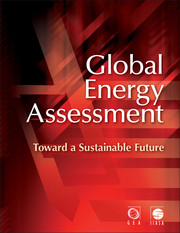Book contents
- Frontmatter
- Contents
- Section 1
- Section 2
- Section 3
- Cluster 1
- Cluster 2
- Chapter 7 Energy Resources and Potentials
- Chapter 8 Energy End-Use: Industry
- Chapter 9 Energy End-Use: Transport
- Chapter 10 Energy End-Use: Buildings
- Chapter 11 Renewable Energy
- Chapter 12 Fossil Energy
- Chapter 13 Carbon Capture and Storage
- Chapter 14 Nuclear Energy
- Chapter 15 Energy Supply Systems
- Chapter 16 Transitions in Energy Systems
- Cluster 3
- Cluster 4
- Section 4
- Index
- References
Chapter 7 - Energy Resources and Potentials
Published online by Cambridge University Press: 05 September 2012
- Frontmatter
- Contents
- Section 1
- Section 2
- Section 3
- Cluster 1
- Cluster 2
- Chapter 7 Energy Resources and Potentials
- Chapter 8 Energy End-Use: Industry
- Chapter 9 Energy End-Use: Transport
- Chapter 10 Energy End-Use: Buildings
- Chapter 11 Renewable Energy
- Chapter 12 Fossil Energy
- Chapter 13 Carbon Capture and Storage
- Chapter 14 Nuclear Energy
- Chapter 15 Energy Supply Systems
- Chapter 16 Transitions in Energy Systems
- Cluster 3
- Cluster 4
- Section 4
- Index
- References
Summary
Executive Summary
An energy resource is the first step in the chain that supplies energy services (for a definition of energy services, see Chapter 1). Energy services are largely ignorant of the particular resource that supplies them; however, often the infrastructures, technologies, and fuels along the delivery chain are highly dependent on a particular type of resource. The availability and costs of bringing energy resources to the market place are key determinants to affordable and accessible energy services.
Energy resources pose no inherent limitation to meeting the rapidly growing global energy demand as long as adequate upstream investment is forthcoming – for exhaustible resources in exploration, production technology, and capacity (mining and field development) and, by analogy, for renewables in conversion technologies.
Hydrocarbons and Nuclear
Occurrences of hydrocarbons and fissile materials in the Earth's crust are plentiful – yet they are finite. The extent of the ultimately recoverable oil, natural gas, coal, or uranium is the subject of numerous reviews, yet still the range of values in the literature is large (Table 7.1). For example, the range for conventional oil is between 4900 exajoules (EJ) for reserves to 13,700 EJ (reserves plus resources) – a range that sustains continued debate and controversy. The large range is the result of varying boundaries of what is included in the analysis of a finite stock of an exhaustible resource, e.g., conventional oil only or conventional oil plus unconventional occurrences, such as oil shale, tar sands, and extra-heavy oils.
- Type
- Chapter
- Information
- Global Energy AssessmentToward a Sustainable Future, pp. 425 - 512Publisher: Cambridge University PressPrint publication year: 2012
References
- 23
- Cited by



